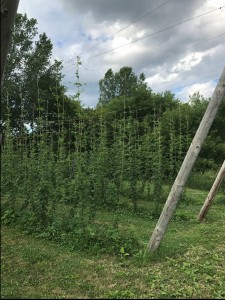What makes a good beer? The right ingredients, according to Paul James and Jeff Larson, Dynamics SL consultants for Boyer & Associates and beer aficionados. They should know — They help produce one of those ingredients.


“We wanted to get into the brewing industry because it was taking off rather rapidly and we saw some opportunities where we could fill the need,” said James.
Starting a brewery seemed like a larger undertaking than they wanted, so instead they went straight to the source: hops, a small, aromatic plant and one of the key ingredients in beer. Hops grow as bines (similar to vines) around a structure and have cones with an aromatic oil or resin that is used in beer. Most hops are dried before being sold to a local craft brewery.
Want to taste what James and Larson created? As of spring 2019, Omni Brewing in Maple Grove is currently buying all of their hops for the foreseeable future.
From white collar to farmer
James and Larson started plans for their farm, Metropolitan Hops, in the fall of 2015 and last spring planted 250 hops on a quarter-acre of farmland in Corcoran, Minn. That’s the minimum number of plants to be considered a commercial hops farm according to the U.S. Hops Association.
The duo quickly realized farming wasn’t as straightforward as they thought it might be. In their first year and a half as hops growers, they have battled Japanese beetles, hail damage, weeds and more.

“Now I have a long list of what could go wrong. It’s been a really big learning curve,” James said. He and Larson spent about 40 to 60 hours prepping the crop this spring, and they spend another three or four hours each week mowing, spraying and tending to the crop.
James said a typical hops farm takes about $10,000 per acre to start and at least three years to break even and start turning a profit. First-year hops are not ready for harvesting and this summer’s hailstorms created another setback for James and Larson.
Larson said he was surprised by “the amount of work that it takes to nurture the plants to get their full potential.”
As with any crop, harvesting will be another time-consuming task: Each plant will need to be pulled down and picked, and then the hops must be dried, turned into pellet form, packaged and delivered. Their effort should pay off though — Metropolitan Hops already has three breweries in the northwest suburbs who want to buy this fall’s crop.
Finding the perfect aroma
James said beer-making is nearly as complex as wine-making is. Beers typically have only four ingredients: water, grain, yeast and hops. With such few ingredients, every subtle change to any one of them makes a big difference in the taste of the beer.
For that reason, craft breweries search long and hard for the perfect ingredients with just the right flavors. Some breweries have their own yeast strain under lock and key to make sure it stays alive and they don’t lose that unique taste.
James likened growing hops to growing grapes for wine. Multiple factors, such as the composition and ph balance of the soil and the weather, make a difference in how any one hops crop tastes.
“Once (breweries) start brewing a beer and they like it, they generally will not buy hops from anywhere else. Even 20 miles away that taste could change,” James said.
More than 100 varieties of hops exist. James and Larson are growing Cascade, one of the most popular varieties. The plant has a pleasant flowery and spicy citrus aroma, offering a subtle grapefruit taste.
“Come fall it’s definitely got a nice smell to it,” James said. The flavor of the hop varies depending on when the plant is harvested. A plant harvested earlier will create a more bitter taste while a hop that stays on the plant for longer will have a more aromatic flavor.
Reviving a 150-year-old industry
Hops grow best in areas with the same latitude as Minnesota, with most of the U.S. crops coming from Washington, Oregon and Idaho. There are only about 50 farms registered with the Minnesota Hops Association.
James said the hops market was thriving here in the 1800s but took a big hit with Prohibition and the Depression. He’s excited to be a part of bringing back a dying industry.
Learn More: A 2018 article in The Growler discussed the revival of hops farms in Minnesota and included an interview with Jeff Larson from Metropolitan Hops.
“There’s a huge demand for locally grown hops and no supply. That’s kind of the appeal too is to bring back this industry that used to thrive in Minnesota,” James said.
Unfortunately, little is known about how hops used to be grown so today’s hops growers are left to figure it out on their own. Growers throughout the U.S. share what knowledge they have gleaned from trial and error.

Growers in Minnesota are working collaboratively and with the University of Minnesota to create a regional strain of hops that would offer a unique flavor, similar to the famed Honeycrisp for apple growers.
“Part of experimentation is that you have to be able to reproduce it if it’s really good,” James said. “It’s way more chemistry and science than I ever thought it would be.”
He and Larson hope to eventually use all 50 acres of land that they own, but they’re taking the first few years to learn and perfect their hops growing skills. They plan to sell their first crop this fall, harvesting in either late August or September.
And as for that perfect beer taste? James prefers an IPA, a beer with a more prominent hops taste. Larson also prefers the IPAs; his motto is “the bitter the better.”








